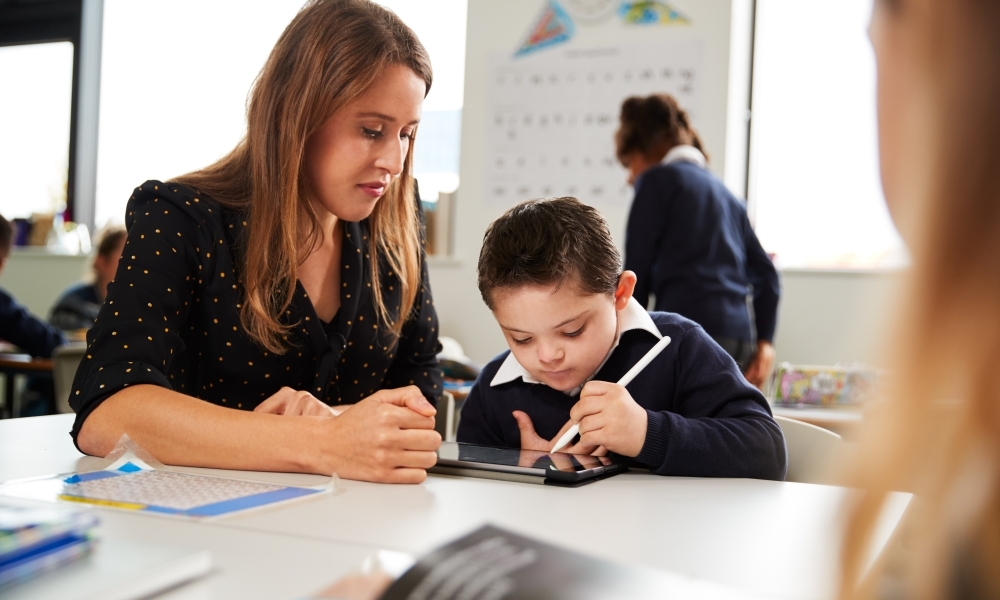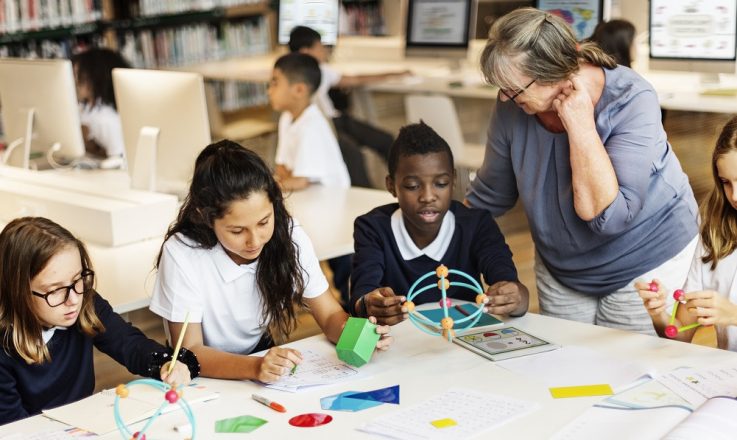Thanks for downloading this episode of The Research Files from Teacher magazine. I’m Dominique Russell.
A study has followed primary school teachers through an entire school year to document how they taught mathematics to be inclusive of children with Down syndrome.
Each teacher involved in the study had a student with Down syndrome in their classroom, and the researchers took note of examples of innovative mathematics teaching practice by observing lessons, looking at the maths work completed by children with Down syndrome, and one-on-one interviews with the teachers involved. As a result of this research, four different ways that teachers can include students with Down syndrome in their maths classrooms have emerged.
Associate Professors Rhonda Faragher, from the University of Queensland, and Associate Professor Barbara Clarke, from Monash University, have published their findings in the Mathematics Education Research Journal. Dr Faragher joins me today to discuss the research. Let’s jump in.
Dominique Russell: So I thought to begin with, it would just be a good idea to get a bit of background on your career in educational research so far, and also your role at the University of Queensland.
Rhonda Faragher: Yes. I began as a secondary maths and science teacher and loved them both, but gradually became more involved in maths and particularly learners who weren’t learning as well as I’d like. And so that took me into education research.
And then I had my daughter with Down syndrome, she was my third child, and so that really focused me, thinking, how am I going to teach her? And then how might I help other people to teach other kids with Down syndrome and other learning difficulties? And it just became something that really is a, probably a life’s journey, because it never ends, really. And my research has changed as she’s grown up and different problems have arisen and different possible solutions have come along, so that’s how my interests have come.
And here at the University of Queensland it was an opportunity to take a position that was focused on inclusive education and in that position I’m also the Director of the Down Syndrome Research Foundation, which I think is rather lovely, because when my daughter was born, I was getting information that was coming out of this study – it’s been going for over 40 years – so it’s been a really special thing to take on, that role as Director.
DR: And so looking at this particular paper then that we’re going to focus on, which is called Inclusive practices in the teaching of mathematics: some findings from research including children with Down syndrome. Can you tell me why you conducted this research? And who exactly was involved in it? And what specifically were you looking at?
RF: This project that this paper is part of, it came about because my colleague Barbara Clarke [the report’s co-author] and I had done previous work of interviewing students with Down syndrome on the task-based interviews that were very prominent in maths education and still are a good way of working with children in the early childhood years.
And when we were studying the results it became something we, we felt there was a teaching effect. That some kids were doing particularly well, and they were being taught well. And we wanted to see what their teachers were doing. So we started to explore the possibilities of looking in classrooms where there were children with Down syndrome being included. And it was a really delightful opportunity for us to be in these very creative places and so that was really the impetus for it, was to see what was happening. Because the research literature is pretty silent on it. You know, you wouldn’t have much to go on at all. And so we wanted to see, and well, my goodness we had fun.
DR: And so you were looking at the primary education space, weren’t you? How many teachers were involved and how long did you follow them for?
RF: We followed them for a year and yes we were in the primary teaching space and we had colleagues and they were research colleagues/partners in our research, and they were in Canberra and in Melbourne.
… The teachers that we had, we had six in the ACT and then we had a further nine in Victoria. And that was a, that was a good size that we could spend close work with these teachers. You know, the studies that are too big only allow you to skim along the surface, whereas we got deeply and closely into these classrooms; and over the year that we spent with them, we watched probably about, for all of them we watched three lessons. For some we went a couple more. But that was a really, really deep involvement with them.
DR: So in the body of the paper, you talk about these four themes that emerged from this research, or four ways that teachers can include students with Down syndrome in the maths classroom, in particular. The first one was particularly interesting, which spoke about deciding when to hold back from ‘telling’ or providing answers to students. So why is that so important, and how did the educators in your study do that successfully?
RF: It is a very big thing in maths education to know not to give the answer and teachers, we all go into teaching because we want to help. And so it’s so tempting when a kid is struggling or they seem to be frustrated to hold back from telling them the answer. But the reason that we want to do that is that we want to help them to think, and think mathematically.
And that idea of productive struggle is a really powerful point. We, if we’re given the answer, that gets us immediately out of that initial feeling of frustration, but what it does is trains us to think that someone else knows the answer and I can’t do it myself, I have to have them tell me what the answer is.
The difficulty with that as well is that – apart from just breeding reliance on the teacher – it doesn’t help us to engage with more sophisticated and more complex mathematical thinking tasks later on. So, that’s an approach that we’ve come to understand in problem solving and teaching mathematical thinking. But, the research evidence suggests that for learners with intellectual disability or just students who are struggling, they have fewer opportunities to think mathematically. They are more likely to be just told the answer, or told to skip over the work altogether, so the opportunities aren’t there for them to learn.
So it’s an important finding in this paper that these teachers didn’t do that. These teachers had this deep belief that these learners with Down syndrome were capable of thinking mathematically and they were going to assist them to do it. So they modelled ways of asking questions, or asking them to self-correct. So one of the teachers in the study, she didn’t tell the student that the diagram was correct, she asked her to look – ‘is it correct? Check it’. And so that idea was teaching that student the sort of questions to ask herself, and also that she was capable of checking it herself and finding out what was the mathematics, you know was her diagram what it needed to be? And that helps her for the next sort of task that she might have to do. So our teachers were very keen to do this. And you could see that it was just part of the way they were.
I think one of the other important findings is that often in Australian classrooms, students with Down syndrome have learning support assistants and it’s really the teacher who has the learning support assistant and it’s not that they’re assigned to that student. There were instances where that position was very well used in the classroom, so the collaboration between the teacher and the learning support assistant were powerful in helping the learner to learn.
There were some instances where the teacher aide, the learning support assistant, didn’t know the mathematics or didn’t know the mathematical point of the lesson. Sometimes there was not a lot of time at the start of a lesson to have that catch-up.
There was also, teacher aides aren’t involved in the planning of lessons. So they have to do things on the fly and one of the effective strategies we saw being used was the teachers taking a few minutes at the start of the lesson to talk through the lesson plan with the teacher aide and explaining what the mathematical point was.
Because it’s often, we found, the teacher aides who are making the decision about when to hold back, when to give more support, when to move on to something else. And that’s really complex decision-making, and so it really relies on these learning support teachers knowing the student well, working closely with the teacher and building up that strong connection, that strong relationship.
And also I think the teachers keeping in touch with what the learner was doing. So if there was a case where something wasn’t going quite as the teacher planned, it wasn’t long before they were onto it and they were redirecting and helping. So there’s some really interesting things that we found emerging from this study.
DR: Absolutely. And can you tell me about the other themes that emerged then, that we haven’t gone over yet?
Yes some of the other themes that we were looking at was making decisions about what mathematics to teach. And in the education of learners with Down syndrome in mathematics, they often are some years behind the curriculum milestones of their peers. And so temptation might be to give them totally different work, maybe what might be called ‘life skills’. Or they might give them work from a much younger age, but the teachers in our study were doing something quite different.
And what they were doing was adjusting the mathematics for their year level. The curriculum that they were teaching the rest of the class, they were making it accessible to the learners with Down syndrome. Now this was a powerful point, because we often are in indecision about what we should teach and there’s not much of a guidance of what to do. But the Australian Curriculum is a year level curriculum and it encourages teachers to do just what the teachers in this study were doing.
And the sorts of things they did was around removing barriers to learning. So if a student had difficulty with handwriting, that’s what they would support. If they had difficulties remembering the count words, they’d make cards so that they had them ready in front of them. So they weren’t removing them from the lesson, or making the material so easy it was quite different. They were really just making the, they were thinking about the individual student and what point of the lesson they were going to have difficulties with, and that was where they brought in the adjustments that might be needed. So that was a powerful one.
And that sort of led into then another theme about learning on the same basis. [That] students with Down syndrome, like all students, like to be with their friends, like to be with their peers. But one of the characteristics that we know is that learners with Down syndrome copy the people around them. Mimicry has been a well-documented characteristic and they’re very good at it.
And so if they’re around kids who have something to teach them, then it’s of benefit. So they love to learn on the same basis. But what does that mean? I mean, that’s a legal phrase, and it sounds quite easy when you put it in a legal document. But when it’s actually in a classroom, we realise it’s complex and very sophisticated teaching that these teachers are doing and they’re making decisions in the moment, often, but really what they’re thinking about is, as a fundamental principle, how do I make it something that ensures that our learners with Down syndrome are there through the whole lesson? So they didn’t go off at different points, they were particularly there at the beginning of the lesson, and there at the cognitive closure when everybody came together to get the main points of the lesson.
And one of the things that we found was really interesting is that these teachers rejected the notion of readiness. So you didn’t teach them fractions until they were ready for them, and ready for them might mean, I don’t know, some hierarchical skills or something that you would normally think would be required before you would begin more complex topics. Multiplication, for example, when you can’t add or you can’t count small collections. And yet our teachers, we saw them doing this. We saw them thinking: ‘How do I engage this learner? How do I keep them working?’ But making the adjustments.
And then another theme was the effective use of resources. So we didn’t find anything that the other kids in the class couldn’t use, it was really that we know that learners with Down syndrome are supported through the use of visuals and use of manipulatives. Well, all learners are. I mean, it’s not something that’s going to harm anybody. And so these teachers really made good use of the mathematics equipment. They explicitly taught how to use them and they were a clear feature of their practice. They expected their students to use them. So they were the themes that we identified with these groups of teachers that we were working with.
DR: And so to pick you up on something that you’ve said previously, and something that we have discussed a little bit in our conversation so far. You’ve said that: ‘Too often in the classroom, we only provide those experiences that we believe the children are ready for (like we’ve said) and that’s an argument that often limits the mathematics to which children with learning disabilities are exposed’. So for teachers who are listening to this, then, who really identify with this statement, how can they go about addressing this, so they’re not unintentionally limiting the learning of some students? Is there anything else that we haven’t already discussed that some of the teachers in your research demonstrated that is quite powerful?
RF: Yes, look there were some really, they were very insightful, the teachers that we were working with. And in the conversations at the conclusion of the year they said things like ‘just have a go’. That was I think – you know, it sounds so glib and easy when I say it, but really what they were saying: ‘look, we just thought it was better that our student was here in this classroom and whatever they get, that we’ll help them’.
… And it’s hard for us to know what a student is picking up in the midst of things. So we don’t withhold language from babies as we’re, we don’t expect them to talk back to us, we don’t expect them to understand it, but we keep using sophisticated language around them and they learn. And this is what our teachers were talking to us about. And they were talking to us about this fundamental idea that if we allow our students to be in classrooms, to be engaged, and to work really closely with them, to notice their learning, to think about how they’re going. They were supporting this learning, they were really getting into that, right at the heart of what these learners could do.
And so ‘just do it’ was part of their saying there aren’t special techniques, but you’ve just got to have a go and explore and adjust things as you go along. So yeah, that was a pretty powerful and important finding, for them to say that.
And then they were also talking about, ‘well maybe they won’t get the detail, but they’ll get the concept’. And I think that’s also another important aspect to think you haven’t got to teach everything in this lesson in this year. They were very aware that there would be times when what they were, the student, was getting at this point – an understanding of the concept – would then form the basis of subsequent work over the years to come. And so there were some really powerful things that I think allowed these, what these teachers communicated back to us was just this sense that this was worth doing, but it was just something that creative teachers have a go, see what happens. And we were all amazed.
DR: And so looking at a broader school community level, then. Are there any implications from this paper that are relevant for school leaders?
RF: Leaders in schools are absolutely critical. It’s really fundamental that teachers need the support of their leader, but I guess it’s more about the philosophical underpinnings of inclusive practice and being supported to do this sort of work.
So having policies and procedures in the school, for example, that allow a teacher to have some time with their teachers aides – it’s probably unrealistic to expect they will have a lot of planning time together, but just having sorts of policies in place that allows the teacher even just to have five minutes of conversation with the teacher aide before a lesson.
It’s also about knowing that this is an approach that makes a big difference to the learning outcomes of all the learners in the class. And being able to support and encourage that that is the structure, that’s the philosophy that’s going on in their school, and then teachers can feel that they are supported, but also can get assistance. Because this is complex and it really is skilled work that takes teachers time to settle in and time to really feel confident with what they’re doing.
Some of the teachers in our study – and they were all outstanding teachers – and one of them who was really probably one of the finest teachers that I’ve ever seen, she disclosed at the end that at the beginning, she felt terrified. Now, I think it’s important to acknowledge that these emotions are strong and they’re existing. Because if we don’t know what to do at the start, we’ve never done it before, it is going to be something that we just have to try, and see how we go, and develop expertise over time.
So, if a teacher is feeling that way but knows they have the support of the leadership team in the school, then that allows them that freedom and perhaps the professional dignity to really have a go, see how things go, but if they’re not going too well, also to have support. And teachers will need professional development often at the time, particularly if they’ve got a learner with a learning disability that is unfamiliar to them, they’ll need that support at the beginning. So leaders are really, really critical.
DR: And just finally then, looking ahead now, are there any further opportunities for more research in this area?
RF: Oh, yes. We’ve moved into the secondary school and we are hoping to fund a project that will do similar work, but look at the secondary level. We’ve done a pilot study and it’s pretty exciting that learners right into the senior school, with Down syndrome, are engaging with the secondary school mathematics curriculum. And we think that there’s great potential for helping low-attainers from whatever cause, not necessarily intellectual disability, but helping those students who are a long way behind their age peers to be able to reengage with the curriculum of the year level for mathematics. So we’re so excited, and we hope we get funded.
… I just would like to thank the participants in our study. It really is a privilege as a researcher to be able to work alongside teachers and to add to the complexity of their classrooms by bringing in cameras and recorders and notepaper and, you know, fitting into sometimes quite tiny rooms as well. And, you know, it’s not to be dismissed lightly, we really see that as a privilege.
Also would like to thank the kids with Down syndrome who allowed us to take their work and talk about what they’ve done, and it’s pretty special.
That's all for this episode. To stay up to date with our Research Files series, be sure to subscribe to our podcast channel on Apple podcasts, Spotify or SoundCloud, so you can be notified of any new episodes. That way, you can also access our other series, like Behaviour Management, School Improvement, Teaching Methods and Teacher Staffroom. While you're there, we'd love for you to rate or review the podcast in your podcast app.
References
Faragher, R.M., & Clarke, B.A. (2020) Inclusive practices in the teaching of mathematics: some findings from research including children with Down syndrome. Mathematics Education Research Journal, 32,
121–146. https://doi.org/10.1007/s13394-019-00294-x
Associate Professor Rhonda Faragher says: ‘The research evidence suggests that for learners with intellectual disability … they have fewer opportunities to think mathematically. They are more likely to be just told the answer, or told to skip over the work altogether, so the opportunities aren’t there for them to learn’.
Thinking about this research statement, reflect on how you work through challenging tasks with students in your classroom, particularly those with an intellectual disability. How often are you assisting students by telling them the answer to a problem? What techniques could you employ to assist students to independently complete a task?



